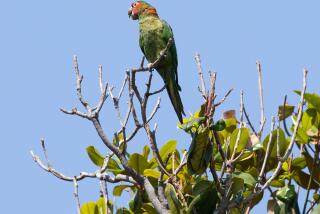PET FOOD SPECIAL : For the Birds
- Share via
“People think it’s cannibalism for a parrot to eat chicken,” says Sally Blanchard, “but they are a different species. It’s like humans eating cows.”
Blanchard’s voice is cracking. “I could talk about birds for 48 hours without shutting up,” she says, and then proceeds to dispel yet another misconception about feathered creatures. “I don’t know where that phrase ‘eat like a bird’ came from. Birds eat a lot. They are attracted to food by color, shape and texture. Food is very exciting to most birds.”
But Blanchard, a bird behaviorist, admits that the fact that birds get excited over food doesn’t mean they’ll eat just anything.
“When I feed my African Gray, Bongo Marie, something she doesn’t like, she’ll throw it on the floor and then look at me and say, ‘Creep.”’
Bongo Marie, who is 19 years old, is just as vocal when she gets something she really likes. “She buries her face in her bowl,” says Blanchard, “and then goes, ‘Mmmmm good.’ She’s is a real little pig.”
According to Blanchard, editor of the Pet Bird Report, a bimonthly magazine subtitled “The Thinking Parrot Owner’s Information Source,” bird owners are divided into two categories: the “involved and educated,” who feed their birds plenty of fresh foods, and the “ignorant and misinformed,” who have turned their pets into seed junkies.
“People think seeds are a natural diet for birds, but they’re not,” says Blanchard. “A seed-only diet is nutritionally abusive, and it’s proven to be psychologically harmful.”
Pat Veschio, a bird hobbyist with 150 aviary companions, agrees. “In the wild, birds eat grubs, beetles, rodents, lizards and all sorts of things. Now my birds eat pork chop bones, lamb bones and chicken legs. I bake a batch of drummettes twice a week and pass them out. They eat all the meat, then they break the bone and eat the marrow. People crack up when they come into my house and see a bunch of birds sitting around gnawing on chicken legs.”
Veschio’s dog, however, doesn’t think it’s so funny. “He isn’t allowed to have chicken bones,” she says, “so he goes around from cage to cage with his nose quivering. Soon he started eating seed. I think it was in retaliation.”
When she got her first birds 26 years ago (“My husband asked me what I wanted for Christmas and I said a parrot--if only we had known”), Veschio instinctively knew the birds needed to eat more than just seed. “But when I told the vet I was giving them chicken bones and things, he ranted and raved that it was terrible. Now he’s telling people that birds can have table food.”
Except when napping or bathing, birds in the wild forage for food, and a great deal of their behavioral rituals--including courtship and breeding--revolve around food. Birds in captivity need variety in their diet too. “Food keeps them stimulated about life,” says Blanchard. “Birds really do live to eat--not eat to live.”
Brown rice, beans, meat, cottage cheese, fresh fruits and vegetables high in Vitamin A--such as carrots, squash and sweet potatoes--are essential foods. “If it’s healthy for us,” says Blanchard, “it’s healthy for them.”
But there are foods birds should avoid, such as chocolate, sugar, butter, salt and avocados (they contains too much fat; also, the meat near the pit can be toxic to birds).
There’s also the problem of peppers. Being from the tropics, parrots are partial to hot, spicy food. “They love to eat jalapen~no peppers,” says Blanchard. “You just don’t want to get a kiss from a bird after they’ve eaten one.”
* For a subscription to the Pet Bird Report ($20 for 6 issues), write PBR Membership, 2236 Mariner Square Drive, #35, Almeda, CA 94501. For more information, call (510) 523-5303; fax (510) 521-6475.
GLOP
Blanchard has been feeding her parrots this “glop” recipe for 20 years. It takes care of a bird’s Vitamin A needs and, when chicken or cottage cheese is added, most of the protein. Birds are very susceptible to bacterial infections, so it’s important not to leave glop in a bird’s cage more than a couple of hours.
4 slices whole-grain bread
1 (2 1/2-ounce) jar baby food, either pureed sweet potato or carrot
1 tablespoon plain yogurt
1 tablespoon minced well-cooked turkey or cottage cheese, optional
Tear or cut bread slices into cubes and place in mixing bowl. Add baby food and yogurt. Lightly toss to combine. Add cooked turkey. Glop should have consistency of turkey stuffing.
* Makes 4 African Gray or 2 Macaw servings.
* Each of 4 African Gray servings, without turkey or cottage cheese, contains about:
64 calories; 131 mg sodium; 1 mg cholesterol; 1 gram fat; 12 grams carbohydrates; 3 grams protein; 0.51 gram fiber.
* Each of 4 African Gray servings, with turkey, contains about: 66 calories; 132 mg sodium; 2 cholesterol; 1 gram fat; 12 grams carbohydrates; 3 protein; 0.51 gram fiber.
More to Read
Sign up for Essential California
The most important California stories and recommendations in your inbox every morning.
You may occasionally receive promotional content from the Los Angeles Times.













